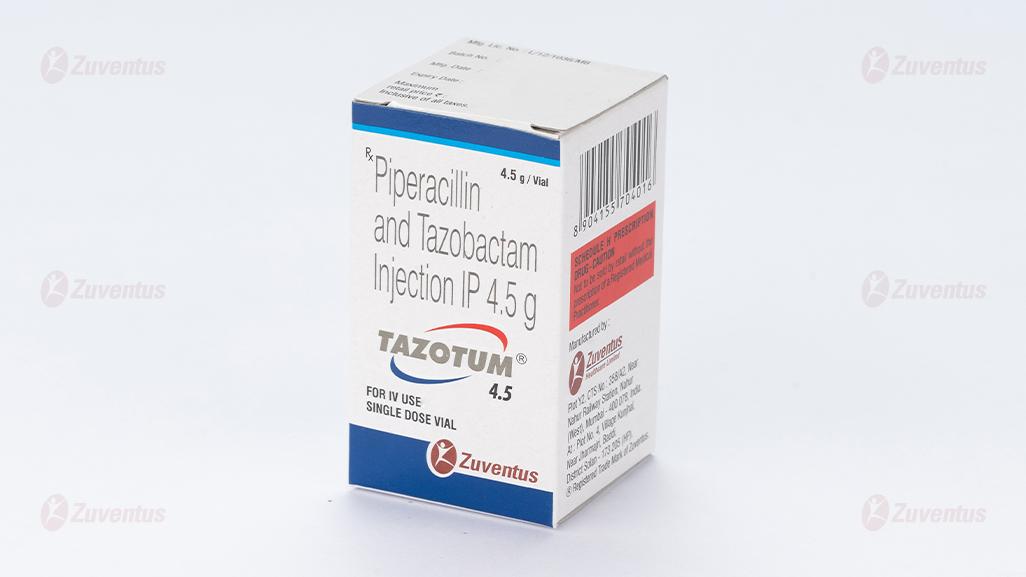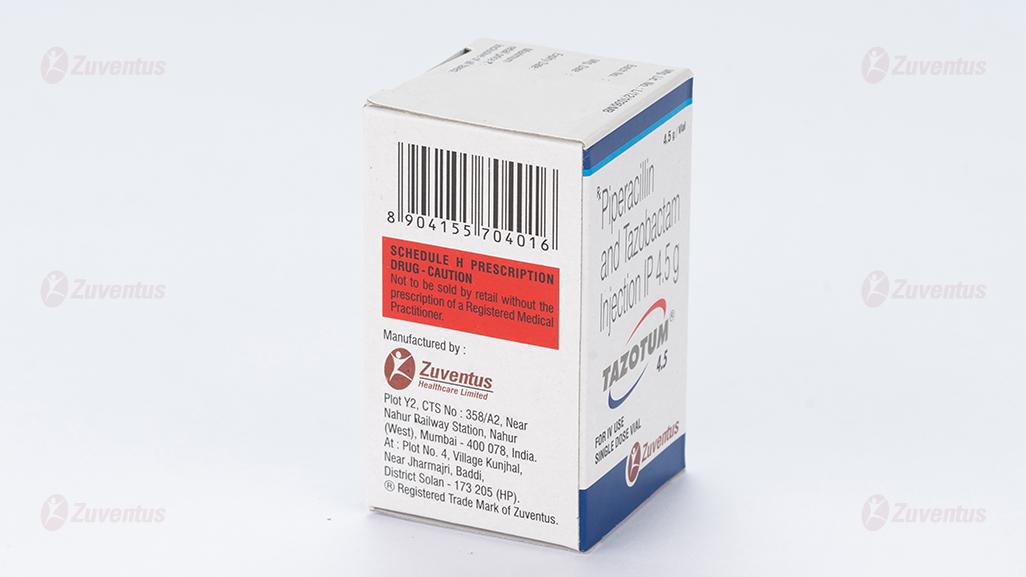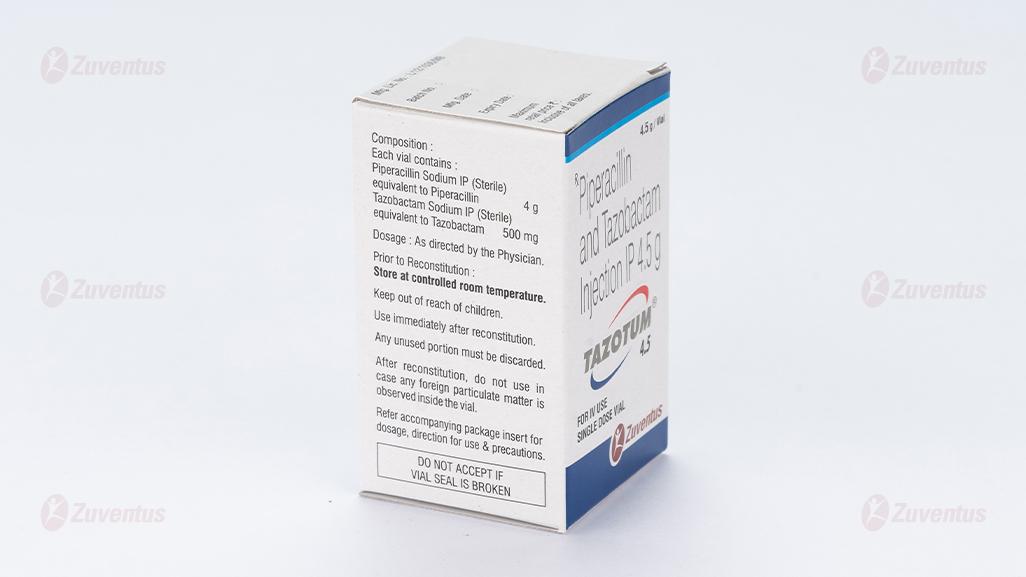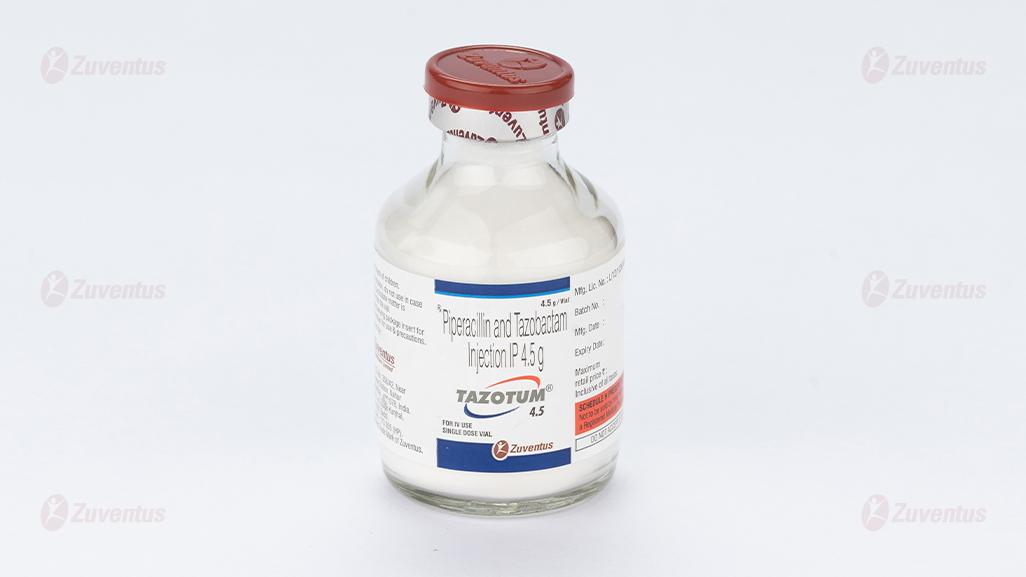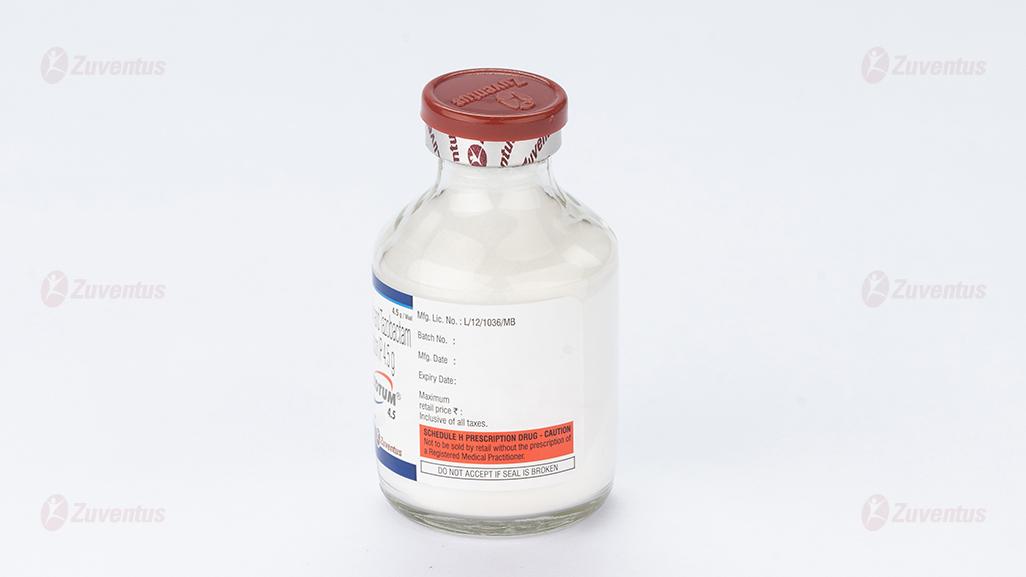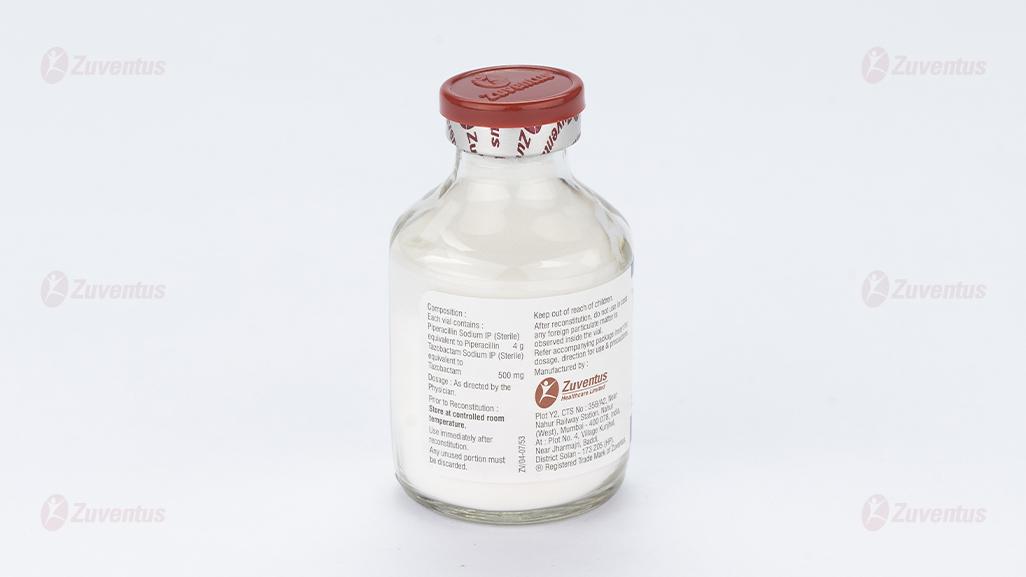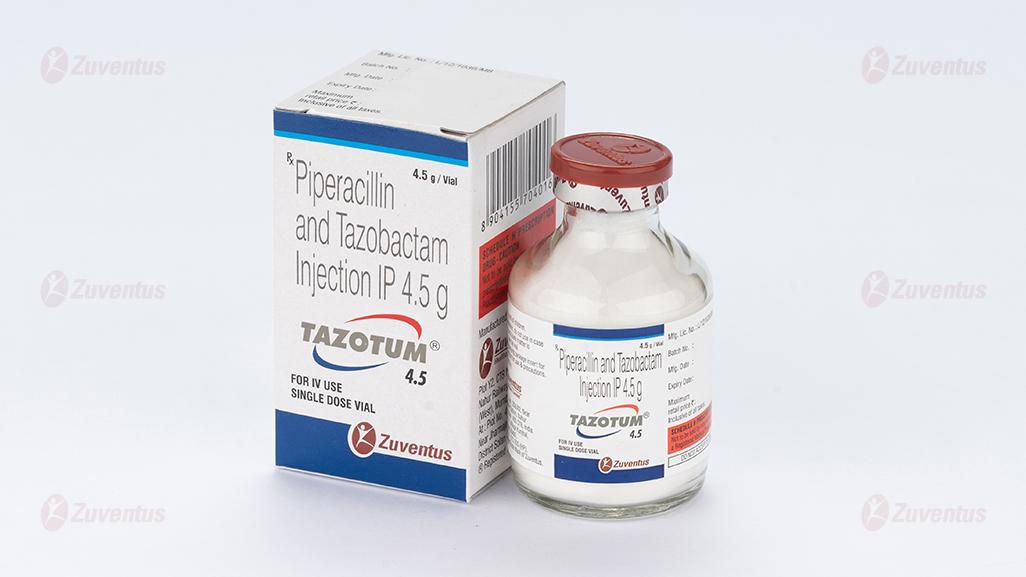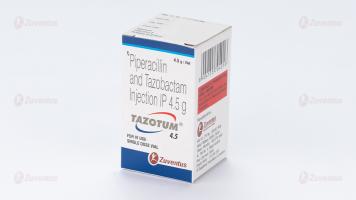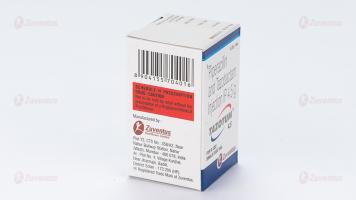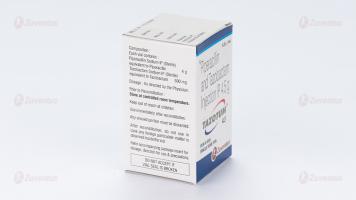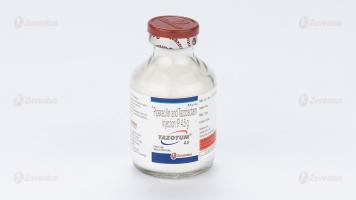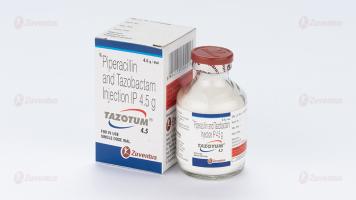TAZOTUM®4.5 Injection
Therapy Area
Anti Infective
1.0 Name of the medicinal product
Piperacillin and Tazobactam injection IP 1.125g /2.25g/ 4.5g
2.0 Qualitative and quantitative composition
TAZOTUM 1.125 Each vial contains:
Piperacillin Sodium IP (Sterile) equivalent to Piperacillin 1 g
Tazobactam Sodium IP (Sterile) equivalent to Tazobactam 125 mg
TAZOTUM 2.25 Each vial contains:
Piperacillin Sodium IP (Sterile) equivalent to Piperacillin 2 g
Tazobactam Sodium IP (Sterile) equivalent to Tazobactam 250 mg
TAZOTUM 4.5 Each vial contains:
Piperacillin Sodium IP (Sterile) equivalent to Piperacillin 4 g
Tazobactam Sodium IP (Sterile) equivalent to Tazobactam 500 mg
3.0 Dosage form and strength
Powder for solution for infusion.
Single Dose Vial containing 1.125g /2.25g/ 4.5g
4.0 Clinical Particulars
4.1 Therapeutic indication
TAZOTUM® is indicated in adults and pediatric patients (2 months of age and older) for the treatment of Lower respiratory tract infections Urinary tract infections Intra-abdominal infections Skin and skin structure infections Bacterial septicemic polymicrobial infections
4.2 Posology and method of administration
Adults
Dosage in Adult Patients with Nosocomial Pneumonia
Initial presumptive treatment of adult patients with nosocomial pneumonia should start with TAZOTUM at a dosage of 4.5 g every six hours plus an aminoglycoside, [totaling 18.0 g (16.0 g piperacillin and 2.0 g tazobactam)], administered by intravenous infusion over 30 minutes. The recommended duration of TAZOTUM treatment for nosocomial pneumonia is 7 to 14 days. Treatment with the aminoglycoside should be continued in patients from whom P. aeruginosa is isolated.
Dosage in Adult Patients with Indications Other Than Nosocomial Pneumonia
The usual total daily dosage of TAZOTUM for adult patients with indications other than nosocomial pneumonia is 3.375 g every six hours [totaling 13.5 g (12.0 g piperacillin and 1.5 g tazobactam)], to be administered by intravenous infusion over 30 minutes. The usual duration of TAZOTUM treatment is from 7 to 10 days.
Dosage in Adult Patients with Renal Impairment
In adult patients with renal impairment (creatinine clearance ≤ 40 mL/min) and dialysis patients (hemodialysis and CAPD), the intravenous dose of TAZOTUM should be reduced based on the degree of renal impairment. The recommended daily dosage of TAZOTUM for patients with renal impairment administered by intravenous infusion over 30 minutes is described in Table 1.
Table 1: Recommended Dosage of TAZOTUM in Patients with Normal Renal Function and Renal Impairment (As total grams piperacillin and tazobactam)#
| Creatinine clearance, mL/min | All Indications (except nosocomial pneumonia) | Nosocomial Pneumonia |
| Greater than 40 mL/min | 3.375 every 6 hours | 4.5 every 6 hours |
| 20 to 40 mL/min* | 2.25 every 6 hours | 3.375 every 6 hours |
| Less than 20 mL/min* | 2.25 every 8 hours | 2.25 every 6 hours |
| Hemodialysis** | 2.25 every 12 hours | 2.25 every 8 hours |
| CAPD | 2.25 every 12 hours | 2.25 every 8 hours |
|
# Administer TAZOTUM by intravenous infusion over 30 minutes. * Creatinine clearance for patients not receiving hemodialysis ** 0.75 g (0.67 g piperacillin and 0.08 g tazobactam) should be administered following each hemodialysis session on hemodialysis days |
||
For patients on hemodialysis, the maximum dose is 2.25 g every twelve hours for all indications other than nosocomial pneumonia and 2.25 g every eight hours for nosocomial pneumonia. Since hemodialysis removes 30% to 40% of the administered dose, an additional dose of 0.75 g TAZOTUM (0.67 g piperacillin and 0.08 g tazobactam) should be administered following each dialysis period on hemodialysis days. No additional dosage of TAZOTUM is necessary for CAPD patients.
Dosage in Pediatric Patients with Appendicitis/Peritonitis or Nosocomial Pneumonia The recommended dosage for pediatric patients with appendicitis and/or peritonitis or nosocomial pneumonia aged 2 months of age and older, weighing up to 40 kg, and with normal renal function, is described in Table 2.
Table 2: Recommended Dosage of TAZOTUM in Pediatric Patients 2 Months of Age and Older, Weighing Up to 40 kg, and with Normal Renal Function#
| Age | Appendicitis and/or Peritonitis | Nosocomial Pneumonia |
| 2 months to 9 months | 90 mg/kg (80 mg piperacillin and 10 mg tazobactam) every 8 (eight) hours | 90 mg/kg (80 mg piperacillin and 10 mg tazobactam) every 6 (six) hours |
| Older than 9 months of age | 112.5 mg/kg (100 mg piperacillin and 12.5 mg tazobactam) every 8 (eight) hours | 112.5 mg/kg (100 mg piperacillin and 12.5 mg tazobactam) every 6 (six) hours |
# Administer TAZOTUM by intravenous infusion over 30 minutes.
Directions for reconstitution and dilution for use:
Intravenous Administration
- For conventional vials, reconstitute TAZOTUM per gram of Piperacillin with 5 ml of a compatible reconstitution diluent from the list provided below.
- 1.125 g, 2.25 g, and 4.5 g TAZOTUM should be reconstituted with 5 ml, 10 ml and 20 ml, respectively. Swirl until dissolved.
- Intravenous injection should be given over at least 3 to 5 minutes.
- Compatible Reconstitution Diluents:
- 0.9% Sodium Chloride for Injection
- Sterile Water for Injections
- Dextrose 5%
Intravenous infusion
- Reconstituted TAZOTUM solution should be further diluted in a compatible intravenous solution listed below.
- Recommended volume per dose is 50 ml to 150 ml.
- Administer by infusion over a period of at least 30 minutes.
- Compatible reconstitution diluents:
- 0.9% Sodium Chloride for Injection.
- Sterile Water for Injections (Maximum recommended volume per dose of is 50 ml).
- Dextrose 5%. Dextran 6% in Saline
4.3 Contraindications
TAZOTUM® is contraindicated in patients with a history of allergic reactions to any of the penicillins, cephalosporins, or β-lactamase inhibitors.
4.4 Special Warnings and Precautions
Warnings:
- Hypersensitivity Reactions: Serious and occasionally fatal hypersensitivity anaphylactic/anaphylactoid) reactions (including shock) have been reported in patients receiving therapy with penicillins including TAZOTUM. Before initiating therapy with TAZOTUM, careful inquiry should be made concerning previous hypersensitivity reactions to penicillins, cephalosporins, other β-lactams, and other allergens.
- Clostridium difficile–Associated Diarrhea: Clostridium difficile-associated diarrhea (CDAD) has been reported with use of nearly all antibacterial agents, including TAZOTUM, and may range in severity from mild diarrhea to fatal colitis.
If CDAD is suspected or confirmed, ongoing antibiotic use may need to be discontinued.
Precautions:
Pregnancy
Pregnancy Category B:
Piperacillin and Tazobactam cross the placenta. TAZOTUM should only be used during pregnancy if clearly indicated, i.e. only if the expected benefit outweighs the possible risks to the pregnant woman and fetus.
Nursing Mothers
Piperacillin is excreted in low concentrations in human milk; Tazobactam concentrations in human milk have not been studied. Caution should be exercised when TAZOTUM is administered to a nursing woman.
Pediatric Use
The safety and effectiveness of TAZOTUM for intra-abdominal infections, and nosocomial pneumonia have been established in pediatric patients 2 months of age and older. Use of TAZOTUM in pediatric patients 2 months of age and older with nosocomial pneumonia and intra-abdominal infections including appendicitis and/or peritonitis is supported by evidence from well-controlled studies and pharmacokinetic studies in adults and in pediatric patients. The safety and effectiveness of TAZOTUM have not been established in pediatric patients less than 2 months of age.
Geriatric Use
- Patients over 65 years are not at an increased risk of developing adverse effects solely because of age. Elderly patients are more likely to have decreased renal function, care should be taken in dose selection and it may be useful to monitor renal function.
- In general, dose selection for an elderly patient should be cautious, usually starting at the low end of the dosing range.
- TAZOTUM contains 64 mg (2.79 mEq) of sodium per gram of Piperacillin in the combination product. At the usual recommended doses, patients would receive between 768 and 1024 mg/day (33.5 and 44.6 mEq) of sodium. This should be taken into account by patients on a controlled sodium diet. The geriatric population may respond with a blunted natriuresis due to salt loading. This may be clinically important with regard to diseases such as congestive heart failure.
General
- Neutropenia and leucopenia may occur especially during prolonged therapy. Therefore, periodic assessment of a complete blood count should be performed.
- Periodic assessment of renal and hepatic functions during prolonged therapy is advisable.
- Bleeding manifestations have occurred in some patients receiving β-lactam antibiotics. These reactions have sometimes been associated with abnormalities of coagulation tests such as clotting time, platelet aggregation and prothrombin time, and are more likely to occur in patients with renal failure. If bleeding manifestations occur, the antibiotic should be discontinued and appropriate therapy instituted.
- The possibility of the emergence of resistant organisms should be kept in mind, particularly during prolonged treatment i.e. ≥21 days. Microbiological follow-up may be required to detect any important superinfection. If this occurs, appropriate measures should be taken.
- Patients may experience neuromuscular excitability or convulsions if higher than recommended doses are given intravenously.
- Hypokalaemia may occur in patients with low potassium reserves or who are receiving concomitant medications that may lower potassium levels; periodic electrolyte determinations should be performed in such patients. Modest elevation of AST, ALT may be observed.
- Piperacillin therapy has been associated with an increased incidence of fever and rash in cystic fibrosis patients.
- In patients with creatinine clearance ≤ 40 mL/min and dialysis patients (hemodialysis and CAPD), the intravenous dose should be adjusted to the degree of renal function impairment.
- Prescribing TAZOTUM in the absence of a proven or strongly suspected bacterial infection or a prophylactic indication is unlikely to provide benefit to the patient and increases the risk of development of drug-resistant bacteria.
4.5 Drug interactions
Aminoglycosides
The mixing of β-lactam antibiotics with aminoglycosides in vitro can result in substantial inactivation of the aminoglycoside. The inactivation of aminoglycosides in the presence of penicillin-class drugs has been recognized.
It has been postulated that penicillin-aminoglycoside complexes are formed and these complexes are microbiologically inactive and of unknown toxicity. Sequential administration of TAZOTUM with tobramycin to patients with normal renal function and mild to moderate renal impairment has been shown to decrease serum concentrations of tobramycin but does not significantly affect tobramycin pharmacokinetics.
When aminoglycosides are administered in combination with Piperacillin to patients with end-stage renal disease requiring hemodialysis, the concentrations of the aminoglycosides (especially tobramycin) may be significantly altered and should be monitored.
Probenecid
Probenecid administered concomitantly with TAZOTUM prolongs the half-life of Piperacillin by 21% and that of Tazobactam by 71%.
Heparin (oral anticoagulants)
Coagulation parameters should be tested more frequently and monitored regularly during simultaneous administration of high doses of heparin, oral anticoagulants, or other drugs that may affect the blood coagulation system or the thrombocyte function.
Vecuronium (Non-depolarising muscle relaxants)
Piperacillin when used concomitantly with vecuronium has been implicated in the prolongation of the neuromuscular blockade of vecuronium. TAZOTUM could produce the same phenomenon if given along with vecuronium. Due to their similar mechanism of action, it is expected that the neuromuscular blockade produced by any of the non-depolarizing muscle relaxants could be prolonged in the presence of Piperacillin.
Methotrexate
Piperacillin may reduce the excretion of methotrexate. Therefore, serum levels of methotrexate should be monitored in patients to avoid substance toxicity.
Vancomycin
No pharmacokinetic interactions have been noted between TAZOTUM & vancomycin.
Drug/Laboratory Test Interactions
- Non-enzymatic methods of measuring urinary glucose may lead to false-positive results, as with other penicillins. It is recommended that glucose tests based on enzymatic glucose oxidase reactions be used.
- A number of chemical urine protein measurement methods may lead to false-positive results. Protein measurement with dip sticks is not affected.
- The direct Coombs' test may be positive. Positive test results for the assays listed above in patients receiving TAZOTUM should be confirmed by other diagnostic methods.
4.6 Use in special populations
- The half-life of Piperacillin and Tazobactam increases by approximately 25% and 18%, respectively, in patients with hepatic cirrhosis compared to healthy subjects.
- The half-life of Piperacillin and Tazobactam increases with decreasing creatinine clearance. The increase in half-life is two-fold and four-fold for Piperacillin and Tazobactam, respectively, at creatinine clearance below 20 ml/min compared to patients with normal renal function.
- Haemodialysis removes 30% to 50% of Piperacillin / Tazobactam, with an additional 5% of the Tazobactam dose removed as the Tazobactam metabolite.
- Peritoneal dialysis removes approximately 6% and 21% of the Piperacillin and Tazobactam doses, respectively, with up to 18% of the Tazobactam dose removed as the Tazobactam metabolite.
Pediatric population
In a population pharmacokinetic analysis, estimated clearance for 9 months to 12-year-old patients was comparable to adults, with a population mean (SE) value of 5.64 (0.34) ml/min/kg. The Piperacillin clearance estimate is 80% of this value for pediatric patients 2 - 9 months of age. The population mean (SE) for Piperacillin volume of distribution is 0.243 (0.011) l/kg and is independent of age.
Elderly patients
The mean half-life for Piperacillin and Tazobactam were 32% and 55% longer, respectively, in the elderly compared with younger subjects. This difference may be due to age-related changes in creatinine clearance.
4.7 Effects on the ability to drive and use machines
The use of TAZOTUM is not expected to affect the ability to drive or use machines.
4.8 Undesirable effects
Infections and infestations:
Candidal superinfection.
Blood and lymphatic system disorders:
Leucopenia, neutropenia, thrombocytopenia, anaemia, bleeding manifestations (including purpura, epistaxis, bleeding time prolonged), eosinophilia, haemolytic anaemia, agranulocytosis, Coombs' direct test positive, pancytopenia, prolonged partial thromboplastin time, prothrombin time prolonged, thrombocytosis.
Immune system disorders: Hypersensitivity reaction, anaphylactic/anaphylactoid reaction (including shock).
Metabolism and nutritional disorders: Hypoalbuminaemia, hypoglycaemia, hypoproteinaemia, hypokalaemia.
Nervous system disorders: Headache, insomnia, muscular weakness, hallucination, convulsion.
Respiratory disorder: Bronchospasm. Vascular disorders: Hypotension, phlebitis, thrombophlebitis, flushing.
Gastrointestinal disorders: Diarrhoea, nausea, vomiting, constipation, dyspepsia, jaundice, stomatitis, abdominal pain, pseudomembranous colitis, dry mouth.
Hepatobiliary disorders: Alanine aminotransferase increased, aspartate aminotransferase increased, bilirubin increased, blood alkaline phosphatase increased, gamma-glutamyltransferase increased, hepatitis.
Skin and subcutaneous tissue disorders: Rash including maculopapular rash, pruritus, urticaria, erythema, bullous dermatitis, erythema multiforme, increased sweating, eczema, exanthema, Stevens-Johnson Syndrome, toxic epidermal necrolysis and Acute Generalized Exanthematosus Pustulosis (AGEP).
Musculoskeletal, connective tissue and bone disorders: Arthralgia, myalgia. Renal and urinary disorders: Blood creatinine increased, interstitial nephritis, renal failure, blood urea nitrogen increased.
General disorders and administration site conditions: Fever, injection site reaction, rigors, tiredness, oedema. The administration of high doses of β-lactams, particularly in patients with renal insufficiency, can lead to encephalopathies (consciousness fluctuation, myoclonus and convulsions). Piperacillin therapy has been associated with an increased incidence of fever and rash in cystic fibrosis patients.
Reporting of side effects
Reporting suspected adverse reactions after authorisation of the medicinal product is important. It allows continued monitoring of the benefit/risk balance of the medicinal product. Healthcare professionals are asked to report any suspected adverse reactions via email to: medico@zuventus.com
Website: http://www.zuventus.co.in/safety.aspx
By reporting side effects, you can help provide more information on the safety of this medicine.
4.9 Overdose
There have been post marketing reports of overdose with Piperacillin/Tazobactam. The majority of those events experienced, including nausea, vomiting, and diarrhea, have also been reported with the usual recommended doses. Patients may experience neuromuscular excitability or convulsions if higher than recommended doses are given intravenously (particularly in the presence of renal failure). Treatment should be supportive and symptomatic according to the patient's clinical presentation. Excessive serum concentrations of either Piperacillin or Tazobactam may be reduced by hemodialysis.
5.0 Pharmacological Properties
5.1 Mechanism of Action
Piperacillin, a broad spectrum, semi-synthetic penicillin, active against many gram-positive and gram-negative aerobic and anaerobic bacteria, exerts bactericidal activity by inhibition of both septum and cell wall synthesis. Tazobactam, a triazolylmethyl penicillanic acid sulphone, is a potent inhibitor of many β-lactamases, in particular the plasmid mediated enzymes which commonly cause resistance to penicillins and cephalosporins including third-generation cephalosporins. The presence of Tazobactam in the Piperacillin/Tazobactam formulation enhances and extends the antibiotic spectrum of Piperacillin to include many β-lactamase producing bacteria normally resistant to Piperacillin and other β-lactam antibiotics. Thus, TAZOTUM combines the properties of a broad spectrum antibiotic and a β-lactamase inhibitor.
5.2 Pharmacodynamic properties
TAZOTUM has been shown to be active against most strains of the following microorganisms both in vitro and in clinical infections.
| Aerobic and facultative gram-positive microorganisms | Aerobic and facultative gram-negative microorganisms | Gram-negative anaerobes |
| Staphylococcus aureus (excluding methicillin and oxacillin-resistant isolates | Acinetobacter baumanii Escherichia coli Haemophilus influenzae (excluding β-lactamase negative, ampicillin-resistant isolates) Klebsiella pneumoniae Pseudomonas aeruginosa (given in combination with an aminoglycoside to which the isolate is susceptible) | Bacteroides fragilis group (B. fragilis, B. ovatus, B. thetaiotaomicron and B. vulgatus) |
The following in vitro data regarding the susceptibility of microorganisms to Piperacillin/Tazobactam is available.
At least 90% of the following microorganisms exhibit an in vitro minimum inhibitory concentration (MIC) less than or equal to the susceptible breakpoint for TAZOTUM.
| Aerobic and facultative gram-positive microorganisms | Aerobic and facultative gram-negative microorganisms | Anaerobes |
| Enterococcus faecalis (ampicillin or penicillin-susceptible isolates only) Staphylococcus epidermidis (excluding methicillin and oxacillin-resistant isolates) Streptococcus agalactiae Streptococcus pneumoniae (penicillin-susceptible isolates only) Streptococcus pyogenes Viridans group streptococci |
Citrobacter koseri Moraxella catarrhalis Morganella morganii Neisseria gonorrhoeae Proteus mirabilis Proteus vulgaris Serratia marcescens Providencia stuartii Providencia rettgeri Salmonella enterica |
Gram-positive anaerobes Clostridium perfringens Gram-negative anaerobes Bacteroides distasonis Prevotella melaninogenica |
5.3 Pharmacokinetics
Absorption
Both Piperacillin and Tazobactam are poorly absorbed after oral administration and therefore can only be administered parenterally. The peak Piperacillin and Tazobactam concentrations after 4 g / 0.5 g administered over 30 minutes by intravenous infusion are 298 µg/ml and 34 µg/ml respectively.
Distribution
Both Piperacillin and Tazobactam are approximately 30% bound to plasma proteins. The protein binding of either Piperacillin or Tazobactam is unaffected by the presence of the other compound. Protein binding of the Tazobactam metabolite is negligible.
TAZOTUM is widely distributed in tissues and body fluids including intestinal mucosa, gallbladder, lung, bile, and bone. Mean tissue concentrations are generally 50 to 100% of those in plasma. Distribution into cerebrospinal fluid is low in subjects with non-inflamed meninges, as with other penicillins.
Biotransformation
Piperacillin is metabolized to a minor microbiologically active desethyl metabolite. Tazobactam is metabolised to a single metabolite that has been found to be microbiologically inactive.
Elimination
Piperacillin and Tazobactam are eliminated via the kidney by glomerular filtration and tubular secretion. Piperacillin is excreted rapidly as unchanged substance, with 68% of the administered dose appearing in the urine. Tazobactam and its metabolite are eliminated primarily by renal excretion, with 80% of the administered dose appearing as unchanged substance and the remainder as the single metabolite. Piperacillin, Tazobactam and desethyl Piperacillin are also secreted into the bile.
- Following single or multiple doses of TAZOTUM to healthy subjects, the plasma half-life of Piperacillin and Tazobactam ranged from 0.7 to 1.2 hours and was unaffected by dose or duration of infusion. The elimination half-lives of both
- Piperacillin and Tazobactam are increased with decreasing renal clearance.
- There are no significant changes in Piperacillin pharmacokinetics due to Tazobactam. Piperacillin appears to slightly reduce the clearance of Tazobactam.
6.0 Nonclinical Properties
6.1 Animal Toxicology or Pharmacology
The aminoglycosides as a class of antibiotics are known to have the potential to cause significant nephrotoxic and ototoxic effects, some of which may be irreversible. Fertility, teratogenicity and postnatal studies of netilmicin in rats and rabbits have not provided any significant evidence of toxicity of netilmicin, particularly following ocular administration.
7.0 Description
TAZOTUM is a combination of the semi synthetic β-lactam antibiotic piperacillin sodium and the β-lactamase inhibitor tazobactam sodium. It has a broad spectrum of antibacterial activity that includes gram-positive and gram-negative aerobic and anaerobic bacteria, including many pathogens producing β-lactamases.
Piperacillin Sodium :
Chemical Name : sodium(2S,5R,6R)-6-[(R)-2-(4-ethyl-2,3-dioxo-1-piperazine-carboxamido)-2-phenylacetamido]-3,3-dimethyl-7-oxo-4-thia-1-azabicyclo[3.2.0]heptane-2-carboxylate
Molecular formula: C23H26N5NaO7S
Molecular weight : 539.5
Chemical structure:

Tazobactam Sodium:
Chemical Name : sodium(2S,3S,5R)-3-methyl-7-oxo-3-(1H-1,2,3-triazol-1-ylmethyl)-4-thia-1-azabicyclo[3.2.0] heptane-2-carboxylate-4,4-dioxide.
Molecular formula: C10H11N4NaO5S
Molecular weight : 322.3
Chemical structure:

8.0 Pharmaceutical particulars
8.1 Incompatibilities
Whenever TAZOTUM is used concurrently with another antibiotic (e.g. aminoglycosides), the drugs must be administered separately. The mixing of TAZOTUM with an aminoglycoside in vitro can result in substantial inactivation of the aminoglycoside.
- TAZOTUM should not be mixed with other drugs in a syringe or infusion bottle since compatibility has not been established.
- TAZOTUM should be administered through an infusion set separately from other drugs unless compatibility is proven.
- Due to chemical instability, TAZOTUM should not be used in solutions that contain sodium bicarbonate.
- Lactated Ringer's (Hartmann's) solution is not compatible with TAZOTUM. • TAZOTUM should not be added to blood products or albumin hydrolysates.
8.2 Shelf life
Refer to the pack.
8.3 Packaging Information
Single Dose Vial
TAZOTUM 1.125: A vial of 1.125 g.
TAZOTUM 2.25:
A vial of 2.25 g.
TAZOTUM 4.5: A vial of 4.5 g.
8.4 Storage and handling instructions
Prior to reconstitution: Store at controlled room temperature.
Keep out of reach of children.
Use immediately after reconstitution.
Any unused portion must be discarded.
After reconstitution, do not use in case any foreign particulate matter is observed inside the vial.
9.0 Patient Counselling Information
Serious Hypersensitivity Reactions
Advise patients, their families, or caregivers that serious hypersensitivity reactions, including serious allergic cutaneous reactions, could occur with use of TAZOTUM that require immediate treatment. Ask them about any previous hypersensitivity reactions to TAZOTUM, other beta-lactams (including cephalosporins), or other allergens.
Hemophagocytic Lymphohistiocytosis
Prior to initiation of treatment with TAZOTUM, inform patients that excessive immune activation may occur with TAZOTUM and that they should report signs or symptoms such as fever, rash, or lymphadenopathy to a healthcare provider immediately.
Diarrhea
Advise patients, their families, or caregivers that diarrhea is a common problem caused by antibacterial drugs, including TAZOTUM, which usually ends when the drug is discontinued. Sometimes after starting treatment with antibacterial drugs, patients can develop watery and bloody stools (with or without stomach cramps and fever) even as late as two or more months after having taken the last dose of the drug. If this occurs, patients should contact their physician as soon as possible.
Antibacterial Resistance
Patients should be counseled that antibacterial drugs including TAZOTUM should only be used to treat bacterial infections. They do not treat viral infections (e.g., the common cold). When TAZOTUM is prescribed to treat a bacterial infection, patients should be told that although it is common to feel better early in the course of therapy, the medication should be taken exactly as directed. Skipping doses or not completing the full course of therapy may (1) decrease the effectiveness of the immediate treatment and (2) increase the likelihood that bacteria will develop resistance and will not be treatable by TAZOTUM or other antibacterial drugs in the future.
Pregnancy and Lactation
Patients should be counseled that TAZOTUM can cross the placenta in humans and is excreted in human milk.
Read all of this leaflet carefully before you start taking this medicine because it contains important information for you.
- Keep this leaflet. You may need to read it again.
- If you have any further questions, ask your doctor or pharmacist.
- This medicine has been prescribed for you. Do not pass it on to others. It may harm them, even if their signs of illness are the same as yours.
- If you get any side effects, talk to your doctor or pharmacist. This includes any possible side effects not listed in this leaflet. See section 4.
What is in this leaflet
1. What TAZOTUM is and what it is used for
2. What you need to know before you take TAZOTUM
3. How to take TAZOTUM
4. Possible side effects
5. How to store TAZOTUM
6. Contents of the pack and other information
1. What Tazotum is and What It is Used for
TAZOTUM (Piperacillin/Tazobactam) injection, for IV use, consists of the semisynthetic antibacterial piperacillin sodium and the β-lactamase inhibitor tazobactam sodium. Piperacillin belongs to the group of medicines known as” broad spectrum penicillin antibiotics”, it can kill many kinds of bacteria. Tazobactam can prevent some resistant bacteria from surviving the effects of piperacillin. This means that when piperacillin and tazobactam are given together, more types of bacteria are killed. Piperacillin/Tazobactam is used in adults and adolescents to treat bacterial infections, such as those affecting the lower respiratory tract (lungs), urinary tract (kidneys and bladder), abdomen, skin or blood. Piperacillin/Tazobactam may be used to treat bacterial infections in patients with septicemic polymicrobic infections. In certain serious infections, your doctor may consider using Piperacillin/Tazobactam in combination with other antibiotics
2. What You Need to Know Before You Take Tazotum
Do not use TAZOTUM
- If you are allergic to piperacillin or tazobactam or any of the other ingredients of this medicine
- If you are allergic to antibiotics known as penicillins, cephalosporins or other betalactamase inhibitors, as you may be allergic to Piperacillin/Tazobactam.
Warnings and precautions
Talk to your doctor, pharmacist or nurse before using TAZOTUM
- If you have allergies. If you have several allergies make sure you tell your doctor or other healthcare professional before receiving this product.
- If you are suffering from diarrhoea before, or if you develop diarrhoea during or after your treatment. In this case, make sure you tell your doctor or other healthcare professional immediately. Do not take any medicine for the diarrhoea without first checking with your doctor.
- If you have low levels of potassium in your blood. Your doctor may want to check your kidneys before you take this medicine and may perform regular blood tests during treatment
- If you have kidney or liver problems, or are receiving haemodialysis. Your doctor may want to check your kidneys before you take this medicine, and may perform regular blood tests during treatment
- If you are taking certain medicines (called anticoagulants) to avoid an excess of blood clotting (see also other medicines and TAZOTUM in this leaflet) or any unexpected bleeding occurs during the treatment. In this case, you should inform your doctor or other healthcare professional immediately.
- If you develop convulsions during the treatment. In this case, you should inform your doctor or other healthcare professional.
- If you think you developed a new or worsening infection. In this case, you should inform your doctor or other healthcare professional.
Children below 2 years
TAZOTUM is not recommended for use in children below the age of 2 years due to insufficient data on safety and effectiveness.
Other medicines and TAZOTUM
Tell your doctor or pharmacist if you are taking, have recently taken or might take any other medicines. Some medicines may interact with piperacillin and tazobactam. These include:
- Medicines for gout(Probenecid). This can increase the time it takes for piperacillin and tazobactam to leave your body.
- Medicines to thin your blood or to treat blood clots (e.g. heparin, warfarin or aspirin).
- Medicines used to relax your muscles during surgery. Tell your doctor if you are going to have a general anaesthetic.
- Methotrexate (medicine used to treat cancer, arthritis or psoriasis). Piperacillin and tazobactam can increase the time it takes for methotrexate to leave your body.
- Medicines that reduce the level of potassium in your blood (e.g. tablets, enhancing urination or some medicines for cancer).
- Medicines containing the other antibiotics tobramycin, gentamycin or vancomycin. Tell your doctor if you have kidney problems.
Effect on laboratory tests
Tell the doctor or laboratory staff that you are taking TAZOTUM if you have to provide a blood or urine sample.
Pregnancy, breast-feeding and fertility
If you are pregnant or breast feeding think you may be pregnant or are planning to have a baby, ask your doctor or other healthcare professional for advice before receiving this medicine. Your doctor will decide if TAZOTUM is right for you. Piperacillin and Tazobactam can pass to a baby in the womb or through breast milk. If you are breast-feeding, your doctor will decide if TAZOTUM is right for you.
Driving and using machines
The use of TAZOTUM is not expected to affect the ability to drive or use machines.
3. How to Take Tazotum
Your doctor or other healthcare professional will give you this medicine through an infusion (a drip for 30 minutes) into one of your veins.
Dosage
The dose of medicine given to you depends on what you are being treated for, your age, and whether or not you have kidney problems.
Adults and adolescents aged 12 years or older
The usual dose is 4 g / 0.5 g of TAZOTUM given every 6-8 hours, which is given into one of your veins (directly into the blood stream).
Children aged 2 to 12 years
The usual dose for children with abdominal infections is 100 mg / 12.5 mg / kg of body weight of TAZOTUM given every 8 hours into one of your veins (directly into the blood stream). The usual dose for children with low white blood cell counts is 80 mg / 10 mg / kg of body weight of TAZOTUM given every 6 hours into one of your veins (directly into the blood stream). Your doctor will calculate the dose depending on your child's weight but each individual dose will not exceed 4 g / 0.5 g of TAZOTUM. You will be given TAZOTUM until the sign of infection has gone completely (5 to 14 days)
Patients with kidney problems
Your doctor may need to reduce the dose of TAZOTUM or how often you are given it. Your doctor may also want to test your blood to make sure that your treatment is at the right dose, especially if you have to take this medicine for a long time.
If you take more TAZOTUM than you should
As you will receive TAZOTUM from a doctor or other healthcare professional, you are unlikely to be given the wrong dose. However, if you experience side effects such as convulsions, or think you have been given too much, tell your doctor immediately.
If you miss a dose of TAZOTUM
If you think you have not been given a dose of TAZOTUM, tell your doctor or other healthcare professional immediately. If you have any further questions on the use of this medicine, ask your doctor or nurse.
4. Possible Side Effects
Like all medicines, this medicine can cause side effects, although not everybody gets them. See a doctor immediately if you experience any of these potentially serious side effects of TAZOTUM
The serious side effects of TAZOTUM are:
Serious skin rashes [(Stevens-Johnson syndrome, dermatitis bullous (Not known), dermatitis exfoliative (Not known), toxic epidermal necrolysis (Rare)] appearing initially as reddish target-like spots or circular patches often with central blisters on the trunk. Additional signs include ulcers in the mouth, throat, nose, extremities, genitals and conjunctivitis (red and swollen eyes). The rash may progress to widespread blistering or peeling of the skin and potentially may be life threatening Severe potentially fatal allergic condition (drug reaction with eosinophilia and systemic symptoms) that can involve the skin and most importantly other organs under the skin such as the kidney and the liver. A skin condition (acute generalised exanthematous pustulosis) accompanied by fever, which consists of numerous tiny fluid filled blisters contained within large areas of swollen and reddened skin Swelling of the face, lips, tongue or other parts of the body (Not known) Shortness of breath, wheezing or trouble breathing (Not known) Severe rash or hives (uncommon), itching or rash on the skin (Common) Yellowing of the eyes or skin (Not known) Damage to blood cells [the signs include: being breathless when you do not expect it, red or brown urine (Not known), nosebleeds (Rare) and small spot bruising (Not known)], severe decrease in white blood cells (Rare) Severe or persistent diarrhoea accompanied by a fever or weakness (Rare)
If any of the following side effects gets serious, or if you notice any side effects not listed in this leaflet, please tell your doctor or other healthcare professional.
Very common side effects (may affect more than 1 in 10 people): Diarrhoea Common · side effects (may affect up to 1 in 10 people) Yeast infection decrease in platelets decrease of red blood cells or blood pigment / haemoglobin, abnormal lab test (positive direct Coombs), prolonged blood clotting time (activated ·partial thromboplastin time prolonged) decrease in blood protein ·headache, sleeplessness abdominal pain, vomiting, nausea, constipation, upset stomach increase in blood liver enzymes skin rash, itching abnormal kidney blood tests fever, injection site reaction
Uncommon side effects (may affect up to 1 in 100 people)
decrease in white blood cells (leukopenia), prolonged blood clotting time ·(prothrombin time prolonged)
decreased blood potassium, decreased blood sugar low blood pressure, inflammation of the veins (felt as tenderness or redness in the affected area), reddening of skin
increase of a blood pigment breakdown product (bilirubin)
skin reactions with redness,
formation of skin lesions,
nettle rash joint and muscle pain
chills
Rare side effects (may affect up to 1 in 1,000 people) are:
severe decrease in white blood cells (agranulocytosis), bleeding of the nose
serious infection of the colon, inflammation of the mucous lining of the mouth
detachment of the top layer of the skin all over the body (toxic epidermal necrolysis)
Not known side effects (cannot be estimated from the available data):
severe decrease of red blood cells, white blood cells and platelets (pancytopenia), decrease in white blood cells (neutropenia), decrease of red blood cells due to premature breakdown or degradation, small spot bruising, bleeding time prolonged, increase of platelets, increase of a specific type of white blood cells (eosinophilia)
allergic reaction and severe allergic reaction
inflammation of the liver, yellow staining of the skin or whites of the eyes
poor kidney functions and kidney problems
a form of lung disease where eosinophils (a form of white blood cell) appear in the lung in increased numbers
Piperacillin therapy has been associated with an increased incidence of fever and rash in cystic fibrosis patients.
Reporting of side effects
If you get any side effects, talk to your doctor, pharmacist or nurse. This includes any possible side effects not listed in this leaflet. You can also report side effects directly:
Website: www.zuventus.co.in and click the tab “Safety Reporting” located on the top right end of the home page. By reporting side effects, you can help provide more information on the safety of this medicine. You can also report the side effect with the help of your treating physician.
5. How to Store Tazotum
Prior to Reconstitution: Store at controlled room temperature. Keep out of reach of children. Use immediately after reconstitution. Any unused portion must be discarded. After reconstitution, do not use in case any foreign particulate matter is observed inside the vial.
6. Contents of the Pack and Other Information
What TAZOTUM contains
TAZOTUM consists of the semisynthetic antibacterial piperacillin sodium and the β-lactamase inhibitor tazobactam sodium.
TAZOTUM 1.125
Each vial contains: Piperacillin Sodium IP (Sterile) equivalent to Piperacillin 1 g Tazobactam Sodium IP (Sterile) equivalent to Tazobactam 125 mg
TAZOTUM 2.25
Each vial contains: Piperacillin Sodium IP (Sterile) equivalent to Piperacillin 2 g Tazobactam Sodium IP (Sterile) equivalent to Tazobactam 250 mg
TAZOTUM 4.5
Each vial contains: Piperacillin Sodium IP (Sterile) equivalent to Piperacillin 4 g Tazobactam Sodium IP (Sterile) equivalent to Tazobactam 500 mg
© Zuventus Healthcare Ltd., 2020. All rights reserved.

